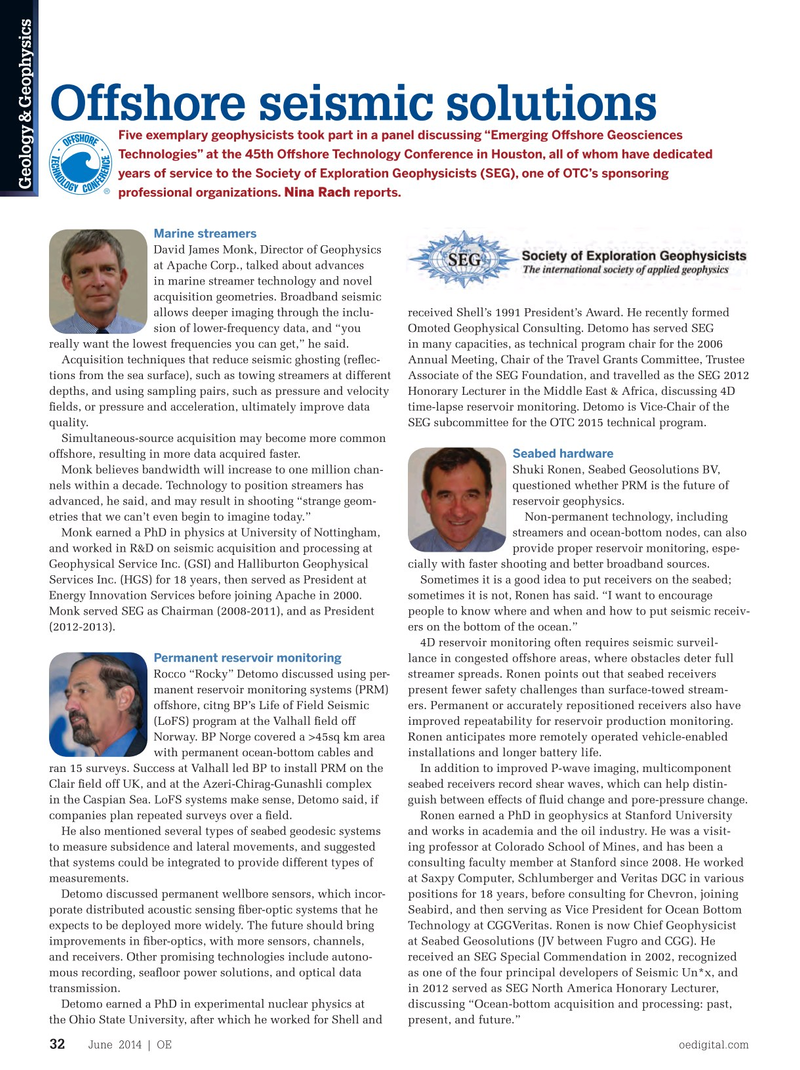
Page 30: of Offshore Engineer Magazine (Jun/Jul 2014)
Read this page in Pdf, Flash or Html5 edition of Jun/Jul 2014 Offshore Engineer Magazine
Offshore seismic solutions
Five exemplary geophysicists took part in a panel discussing “Emerging Ofshore Geosciences
Technologies” at the 45th Ofshore Technology Conference in Houston, all of whom have dedicated years of service to the Society of Exploration Geophysicists (SEG), one of OTC’s sponsoring
Geology & Geophysics
Nina Rach professional organizations. reports.
Marine streamers
David James Monk, Director of Geophysics at Apache Corp., talked about advances in marine streamer technology and novel acquisition geometries. Broadband seismic allows deeper imaging through the inclu- received Shell’s 1991 President’s Award. He recently formed sion of lower-frequency data, and “you Omoted Geophysical Consulting. Detomo has served SEG really want the lowest frequencies you can get,” he said. in many capacities, as technical program chair for the 2006
Acquisition techniques that reduce seismic ghosting (refec- Annual Meeting, Chair of the Travel Grants Committee, Trustee tions from the sea surface), such as towing streamers at different Associate of the SEG Foundation, and travelled as the SEG 2012 depths, and using sampling pairs, such as pressure and velocity Honorary Lecturer in the Middle East & Africa, discussing 4D felds, or pressure and acceleration, ultimately improve data time-lapse reservoir monitoring. Detomo is Vice-Chair of the quality. SEG subcommittee for the OTC 2015 technical program.
Simultaneous-source acquisition may become more common
Seabed hardware offshore, resulting in more data acquired faster.
Monk believes bandwidth will increase to one million chan- Shuki Ronen, Seabed Geosolutions BV, nels within a decade. Technology to position streamers has questioned whether PRM is the future of advanced, he said, and may result in shooting “strange geom- reservoir geophysics. etries that we can’t even begin to imagine today.” Non-permanent technology, including
Monk earned a PhD in physics at University of Nottingham, streamers and ocean-bottom nodes, can also and worked in R&D on seismic acquisition and processing at provide proper reservoir monitoring, espe-
Geophysical Service Inc. (GSI) and Halliburton Geophysical cially with faster shooting and better broadband sources.
Services Inc. (HGS) for 18 years, then served as President at Sometimes it is a good idea to put receivers on the seabed;
Energy Innovation Services before joining Apache in 2000. sometimes it is not, Ronen has said. “I want to encourage
Monk served SEG as Chairman (2008-2011), and as President people to know where and when and how to put seismic receiv- (2012-2013). ers on the bottom of the ocean.” 4D reservoir monitoring often requires seismic surveil-
Permanent reservoir monitoring lance in congested offshore areas, where obstacles deter full
Rocco “Rocky” Detomo discussed using per- streamer spreads. Ronen points out that seabed receivers manent reservoir monitoring systems (PRM) present fewer safety challenges than surface-towed stream- offshore, citng BP’s Life of Field Seismic ers. Permanent or accurately repositioned receivers also have (LoFS) program at the Valhall feld off improved repeatability for reservoir production monitoring.
Norway. BP Norge covered a >45sq km area Ronen anticipates more remotely operated vehicle-enabled with permanent ocean-bottom cables and installations and longer battery life.
ran 15 surveys. Success at Valhall led BP to install PRM on the In addition to improved P-wave imaging, multicomponent
Clair feld off UK, and at the Azeri-Chirag-Gunashli complex seabed receivers record shear waves, which can help distin- in the Caspian Sea. LoFS systems make sense, Detomo said, if guish between effects of fuid change and pore-pressure change. companies plan repeated surveys over a feld. Ronen earned a PhD in geophysics at Stanford University
He also mentioned several types of seabed geodesic systems and works in academia and the oil industry. He was a visit- to measure subsidence and lateral movements, and suggested ing professor at Colorado School of Mines, and has been a that systems could be integrated to provide different types of consulting faculty member at Stanford since 2008. He worked measurements. at Saxpy Computer, Schlumberger and Veritas DGC in various
Detomo discussed permanent wellbore sensors, which incor- positions for 18 years, before consulting for Chevron, joining porate distributed acoustic sensing fber-optic systems that he Seabird, and then serving as Vice President for Ocean Bottom expects to be deployed more widely. The future should bring Technology at CGGVeritas. Ronen is now Chief Geophysicist improvements in fber-optics, with more sensors, channels, at Seabed Geosolutions (JV between Fugro and CGG). He and receivers. Other promising technologies include autono- received an SEG Special Commendation in 2002, recognized mous recording, seafoor power solutions, and optical data as one of the four principal developers of Seismic Un*x, and transmission. in 2012 served as SEG North America Honorary Lecturer,
Detomo earned a PhD in experimental nuclear physics at discussing “Ocean-bottom acquisition and processing: past, the Ohio State University, after which he worked for Shell and present, and future.”
June 2014 | OE oedigital.com 32 000_OE0614_G&G1.indd 32 5/22/14 9:51 PM

 29
29

 31
31